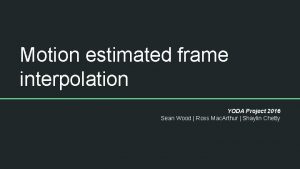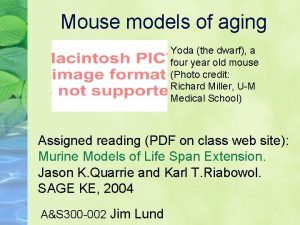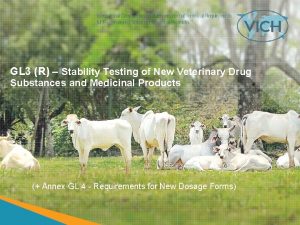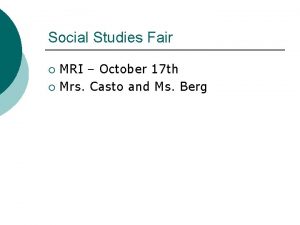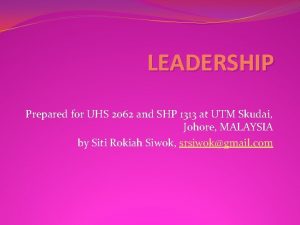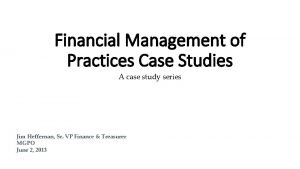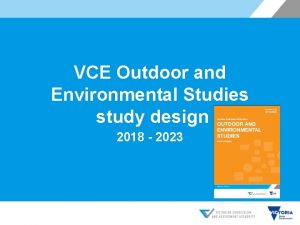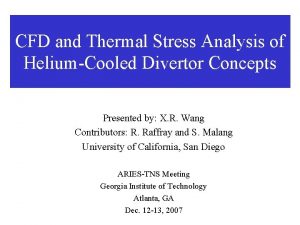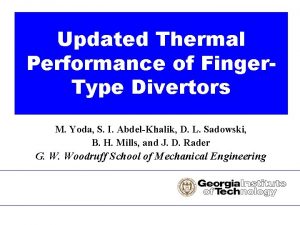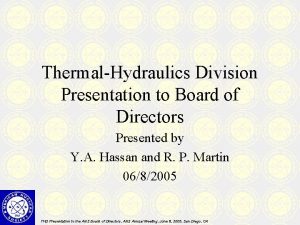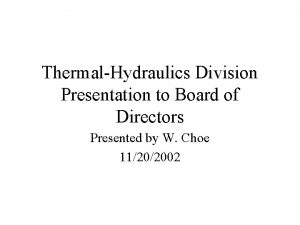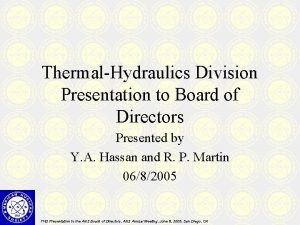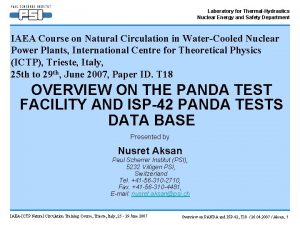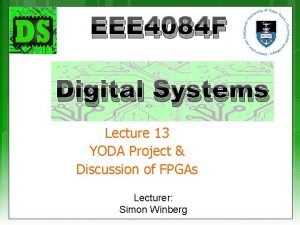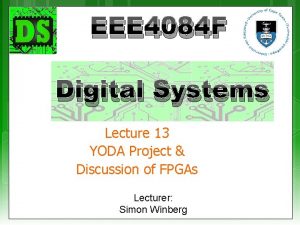ThermalHydraulics Studies of HeliumCooled Divertors M Yoda S







![Experimental Results Ti = 300 C p 400 C Nu [-] q 4. 5 Experimental Results Ti = 300 C p 400 C Nu [-] q 4. 5](https://slidetodoc.com/presentation_image/153fcce9d2242b5e7114bd7eb1287952/image-8.jpg)








- Slides: 16

Thermal-Hydraulics Studies of Helium-Cooled Divertors M. Yoda, S. I. Abdel-Khalik, B. Zhao and S. A. Musa July 28, 2016

He-Cooled Divertors • “Divert” ~20% of energy from burning plasma away from first wall onto divertor target surfaces • Target surfaces subject to very high heat fluxes (>10 MW/m 2 steady state; much higher transient values) • Helium-cooled (solid) tungsten-alloy divertors most developed divertor concept – Concepts studied by KIT (FZK), ARIES: HEMJ, HEMP, T-tube, HCFP, integrated plate-finger design – Issues with W surfaces exposed to plasma containing He: erosion/redeposition, nanobubbles, fuzz, D retention, … – Only divertor concept experimentally shown to remove >10 MW/m 2 steady-state Fusion Matls Workshop (7/16) 2

Introduction Aim • Evaluate thermal-hydraulic performance of leading He-cooled divertor designs at prototypical conditions using dynamically similar experiments at nearly prototypical conditions and numerical simulations Research Objectives • Experimentally test modules that closely mimic current divertor designs at nearly prototypical conditions • Perform numerical simulations validated by experimental data • Estimate maximum heat flux and He pumping power requirements • Determine numerically whether divertor designs can be simplified and/or improved Fusion Matls Workshop (7/16) 3

He-Cooled Multi-Jet Divertor • HEMJ: design proposed for DEMO – Jet impingement cooling: 6. 8 g/s He at (600 °C, 10 MPa) exits from 25 (24 0. 6 mm dia. + one 1. 04 mm dia. ) holes into H = 0. 9 mm gap – ~106 modules to cool O(100 m 2) divertor • KIT/Efremov experiments Norajitra et al. 15 – Single module at prototypical conditions withstood >103 cycles at 9 14 MW/m 2 – Nine-finger module at (500 °C, 10 MPa) tested to 6 MW/m 2 – Complex geometry need to develop new fabrication methods: W Tile 18 m W-alloy shell 15 mm 18 mm m Steel cartridge deep drawing thimbles, powder injection molding (PIM) tiles Fusion Matls Workshop (7/16) 4

Experimental Approach • Test at near-prototypical conditions in GT helium loop – He mass flow rate ṁ 10 g/s, inlet temperature Ti < 420 °C (vs. 600 °C), inlet pressure pi 10 MPa – RF induction heater [INL STAR facility]: heat flux q from He energy balance (less than actual incident flux due to losses) – q 6. 6 MW/m 2: decreases as Ti due to thermal losses – Match dimensionless ṁ (Reynolds number Re) and fraction of heat removed by convection, vs. conduction (Biot number Bi thermal conductivity ratio ks / k for geometrically similar studies) – Measure cooled surface and coolant temperatures, pressure drop – Determine correlations for dimensionless HTC (Nusselt number) Nu = f (Re, ) [neglecting Prandtl number effects] and loss coefficient KL = g (Re) Fusion Matls Workshop (7/16) 5

Current GT Helium Loop Induction heater • Evacuate loop, then charge to 10 MPa Test section P T T P from 41. 3 MPa source tanks • Control mass flow rate ṁ with bypass – Filters remove >7 μm particulates • Heat He with recuperator + electric heater Fusion Matls Workshop (7/16) He source tank Compressor Venturi P Recuperator meter Buffer tank Vacuum pump T Buffer tank Heater Cooler 6

HEMJ (J 1 -c) Test Section • WL 10 (99% W, 1% La 2 O 3) outer shell + stainless jets inner cartridge with adjustable gap width H q – Thermocouples (TCs) embedded 0. 5 mm from cooled surface of outer shell average cooled surface temperature Tc • Experiments at H = 0. 47 0. 03 mm, 0. 86 0. 02 mm, 1. 28 0. 04 mm – Focus on higher inlet temperatures Ti = 300 400 C – Determine average and standard deviation from 10 measurements taken with air-dry clay at a given setting • Reynolds number Re = 1. 3 104 5. 4 104 (ṁ 3 8 g/s) – Prototypical ṁ = 6. 8 g/s Rep = Fusion Matls Workshop (7/16) 2. 14 104 at Ti = 634 °C Dimensions in mm 7
![Experimental Results Ti 300 C p 400 C Nu q 4 5 Experimental Results Ti = 300 C p 400 C Nu [-] q 4. 5](https://slidetodoc.com/presentation_image/153fcce9d2242b5e7114bd7eb1287952/image-8.jpg)
Experimental Results Ti = 300 C p 400 C Nu [-] q 4. 5 MW/m 2 – Nu independent of H – Re-examine correlation at Ti 300 C Mills et al. 15 • KL 1. 8 for H = 0. 47, 0. 86 mm H = 0. 47, 0. 86, 1. 28 mm Re [/104] Fusion Matls Workshop (7/16) • Nu less than previous results at lower Ti and correlation – KL 1. 86 for 1. 28 mm – Pressure transducer recalibrated – Simulations predict KL 1. 77 8

HEMJ Optimization • Can HEMJ design be modified to simplify manufacture while keeping similar thermal performance? Curved – 25 jets of different diameters impinging on curved surface – Consider instead fewer and larger impinging jets, all of Jets same diameter, impinging on and cooling flat surface Thimble Cartridge • Numerical simulations – Coupled CFD / thermal stress analysis: model 60° wedge using standard k turbulence model – Validate with experimental data from He loop – Investigate effect of jet exit diameter D (all jets same dia. ), spacing s on thermal performance quantified in terms of Nu, maximum h, maximum Tc, thermal stresses – Thermal stress analysis: one-way coupling, with CFD results used as loads for FEM model – Test “best” result in He loop to validate simulations Fusion Matls Workshop (7/16) Flat Fluid 9

Jet Array Parameterization • Vary number of rows and jets # Rows – Total jet area, V kept constant radii [mm] # Jets 1 D [mm] 3. 11 7 1. 18 13 19 25 0. 865 0. 715 0. 624 – Only designs with projected row (s/D) and jet (j/D) spacings within ~1 – Rows spaced evenly cartridge diameter for flat surfaces – Hexagonal array of jets: 30° 120° wedges, depending on symmetry – Up to 7 106 cells • Vary H for each geometry – H = 0. 5, 0. 75, 0. 9, 1. 25, 1. 5 mm Fusion Matls Workshop (7/16) # Jets 0 1 3. 5 2 2. 2, 6. 5 3 2. 2, 4. 1, 6. 5 4 2. 2, 3. 5, 4. 8, 6. 5 7 7 13 19 25 CR 4 H 25 25 FR 4 H 25 s j 10

Preliminary Results • Results for HEMJ at prototypical conditions suggest: – Temperature differences over cooled surface as great as ~127 °C – Maximum von Mises stress on cooled surface ~388 MPa – Change in H due to diff. thermal expansion as great as 0. 22 mm (vs. 0. 9 mm) • Optimizations can achieve similar h, lower p with fewer jet holes and/or rows in some cases CFD Analysis (HEMJ) T [°C] 997 60° Structural Analysis (HEMJ) v. Mises stress [MPa] Expansion [mm] 7724 0. 318 0 0 r 870 z Re = 2. 2 104 Ti = 600 C q = 10 MW/m 2 h = 35. 3 k. W/(m 2·K) 11

New GT He Loop • Design and build larger He loop with ṁ 100 g/s – Experimental studies of other divertor designs: HCFP, 9 -finger HEMJ module – Space for loop under renovation • Biggest challenge: creating nearly prototypical heat fluxes on test section – Current induction heater cannot provide 10 MW/m 2 on large (at least 20 cm 2) areas – Try reversed heat flux approach: reverse direction of heat transfer by heating plasma-facing surface with hot He, cooling with water: estimate heat transfer and h from energy balance of coolant, i. e. , water Ovchinnikov et al. 05 – Pros: Suitable for large areas; greatly reduces maximum T loop components and test sections can be fabricated from standard materials – Cons: Only characterizes heat transfer; no information on materials Fusion Matls Workshop (7/16) 12

Design Simulations • Initial study: numerical simulations of HEMJ test section Fusion Matls Workshop (7/16) Cooler Test section P T T P Heater – Current configuration: heat transferred to He: Ti 600 C; To 700 C – Reversed configuration: He heats water, which cools surface by jet impingement: Ti 700 C; To 600 C – Estimate impinging jet parameters required to remove q = 5 10 MW/m 2 without boiling 13

Impinging Jet “Cooler” • Simulate impinging jet of water in pressurized tank – Jet issues from 2 cm dia. pipe into tank at 2 MPa, 27 C: fully-developed turbulent pipe flow at exit at Exit Rew = 7. 5 104 3. 7 105 (ṁw = 1 5 kg/s) – Impinges upon brass disk modeling HEMJ plasma-facing surface (2 cm dia. Tank Pipe 0. 4 cm thickness): impose uniform heat flux BC over disk – Numerical model = radial slice of entire tank + pipe 2. 3 105 cells Jet 4 cm – Standard k- turbulence model Disk q – Temperature-dependent properties (NIST) Fusion Matls Workshop (7/16) 14

Initial Results – Can cool heat fluxes up to 7. 5 MW/m 2 q = 5, 7. 5, 10 MW/m 2 TL [ C] • Based on h from HEMJ simulations at prototypical conditions, T 365 C TL 335 C for Ti 700 C • Temperatures on impingement surface Tu < Tsat (2 MPa) = 212 C no boiling T U TL Fusion Matls Workshop (7/16) q Rew [/104] 15

Current Status • Helium loop upgraded to higher inlet temperatures: Ti 400 °C – Challenges in measurements at Ti 300 C: consistency in H, seals, achieving steady-state conditions – Replacing Cu with Inconel X-750 gaskets (PHENIX) • Numerical simulations of HEMJ “variants”: thermal stress analysis and CFD – How significant is differential thermal expansion at higher Ti? – Can HEMJ design be simplified (fewer jets, flat surface)? • Experimental studies on HEMJ at Ti 300 C, H = 0. 5 1. 5 mm – Acquire more data to evaluate correlation • Designing larger He loop: ṁ 100 g/s – Initial design simulations for HEMJ suggest q = 7. 5 MW/m 2 possible with reversed heat flux approach using jet-impingement cooling – Validate simulations with small-scale impinging jet experiment Fusion Matls Workshop (7/16) 16
 You have much to learn
You have much to learn Yoda
Yoda What do you like to do in your free time in spanish
What do you like to do in your free time in spanish Yoda lifespan
Yoda lifespan Owasp yoda
Owasp yoda Paradigm shift from women studies to gender studies
Paradigm shift from women studies to gender studies Vich gl 39
Vich gl 39 Media and creative studies
Media and creative studies Exploring social studies lesson 1 thinking like a historian
Exploring social studies lesson 1 thinking like a historian Wv social studies fair abstract
Wv social studies fair abstract Universalist theories of leadership
Universalist theories of leadership Cross sectional study advantages and disadvantages
Cross sectional study advantages and disadvantages Financial management case study
Financial management case study Outdoor ed study design
Outdoor ed study design Ct social studies framework
Ct social studies framework Ajou university graduate school
Ajou university graduate school Ecology is a science which studies the relationship between
Ecology is a science which studies the relationship between

